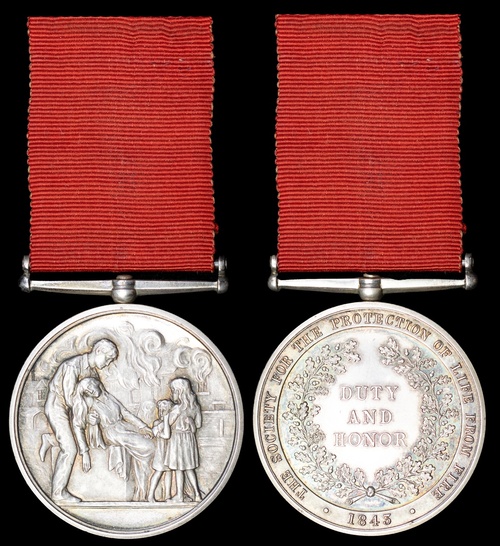
Auction: 24113 - Orders, Decorations and Medals - e-Auction
Lot: 683
The Medal of the Society for the Protection of Life from Fire awarded to William E. Ward, who pulled Lieutenant F. N. Clark, Royal Flying Corps, from his crashed aircraft in London on 29 April 1917
Medal of the Society for the Protection of Life from Fire, Type IV, silver issue, (William E. Ward, Streatham. 29 April 1917.), impressed naming, extremely fine
Wiliam E. Ward, a native of South London and working as a clerk, attempted to save Lieutenant F. N. Clark from his burning aircraft on 29 April 1917 at Streatham, London. Ward of Park Road, West Dulwich went to his assistance and liberated him from the burning aircraft but he was so badly injured Clark died the same day. Ward received the silver medal and £10 for his efforts.
Frank Nelham Clark was born on 1 December 1897 and attended Dulwich College. Soon after the outbreak of the Great War he joined the Inns of Court Officer Training Corps and subsequently became one of their instructors. Besides being a competent gymnast he was also a good swimmer and whilst serving with the Inns of Court saved a comrade from drowning. He received his temporary commission in September 1916 and afterwards graduated as a Pilot in the Royal Flying Corps. Clark was attached to the 56th Reserve Squadron and was expected to have proceeded to join the Expeditionary Force and received his wings only a week before his untimely death. Clark is buried in Norwood Cemetery.
'While flying near Streatham Common, on Sunday afternoon, Lieutenant F.A. Clark, of the Royal Flying Corps had to descend to a low altitude owing to engine trouble. He tried to plane down to a field opposite Leilgham (sic) Court Road, but his machine struck the top of a high tree, and before he could straighten out the aeroplane crashed into the table of a house and fell on a garage. The machine immediately burst into flames and Lieutenant Clark was severely burned. By a coincidence the house with which the machine came into collision was that of the airman's father, who, on hearing the crash, rushed out and rescued his son from the burning wreckage. Nothing but the steel skeleton was left of the aeroplane. Lieutenant Clark died from his injuries later in his own home. According to a description of the accident given by an eye-witness, the machine flew over from the north at a good height, then swung round and came down quite low. At this height it carried out a series of evolutions over the district. After a time the airman appeared to let his machine come down so low that he just skimmed the houses, and the propeller could be plainly seen - a circumstance which seemed to show that the engine was not running. Presently, apparently restarting his engine, the pilot flew off, but a few minutes later came back and gradually descended over the same spot. Again the propellor blades could be seen. Then came a sudden smash, and the aeroplane fell on a garage between two large houses. A few seconds later the engine burst into flame, sending up columns of black smoke.'
Subject to 20% VAT on Buyer’s Premium. For more information please view Terms and Conditions for Buyers.
Sold for
£800
Starting price
£140




